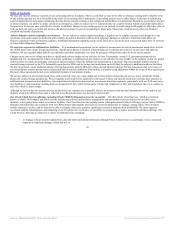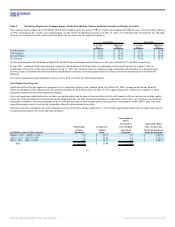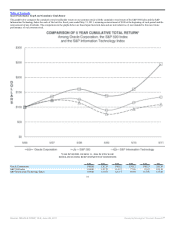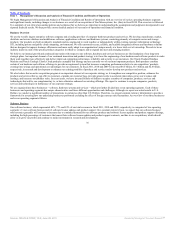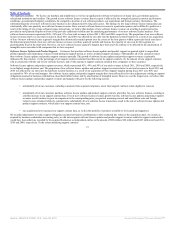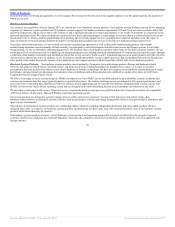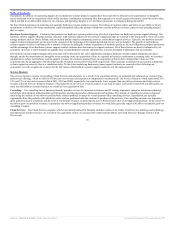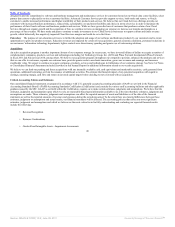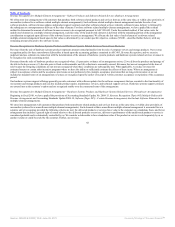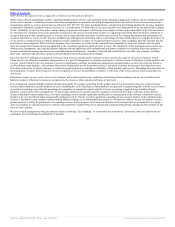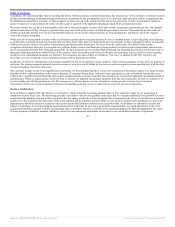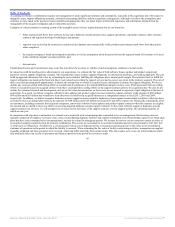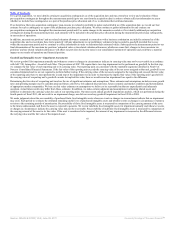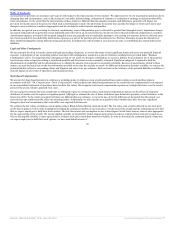Oracle 2010 Annual Report Download - page 44
Download and view the complete annual report
Please find page 44 of the 2010 Oracle annual report below. You can navigate through the pages in the report by either clicking on the pages listed below, or by using the keyword search tool below to find specific information within the annual report.
Table of Contents
designed to provide comprehensive software and hardware management and maintenance services for customers hosted at our Oracle data center facilities, select
partner data centers or physically on-site at customer facilities. Advanced Customer Services provides support services, both onsite and remote, to Oracle
customers to enable increased performance and higher availability of their products and services. We believe that our Cloud Services offerings provide our
customers with increased business performance, reduced risk, a predictable cost and more flexibility and choice in terms of service in order to maximize the
performance of their Oracle software and hardware products and services. While we have grown the base of customers that purchase certain of our Cloud
Services through our organic growth and the acquisition of Sun, we continue to focus on managing our expenses to increase our margins and margins as a
percentage of our revenues. We have made and plan to continue to make investments in our Cloud Services businesses to support current and future revenue
growth, which historically has negatively impacted Cloud Services margins and could do so in the future.
Education: The purpose of our education services is to further the adoption and usage of our software and hardware products by our customers and to create
opportunities to grow our product revenues. Education revenues are impacted by certain of our acquisitions, general economic conditions, personnel reductions in
our customers’ information technology departments, tighter controls over discretionary spending and greater use of outsourcing solutions.
Acquisitions
An active acquisition program is another important element of our corporate strategy. In recent years, we have invested billions of dollars to acquire a number of
complementary companies, products, services and technologies including Art Technology Group, Inc. (ATG) and Phase Forward Incorporated (Phase Forward)
in fiscal 2011 and Sun in fiscal 2010, among others. We believe our acquisition program strengthens our competitive position, enhances the products and services
that we can offer to customers, expands our customer base, provides greater scale to accelerate innovation, grows our revenues and earnings, and increases
stockholder value. We expect to continue to acquire companies, products, services and technologies in furtherance of our corporate strategy. See Note 2 of Notes
to Consolidated Financial Statements included elsewhere in this Annual Report for additional information related to our recent acquisitions.
We believe we can fund our pending and future acquisitions with our internally available cash, cash equivalents and marketable securities, cash generated from
operations, additional borrowings or from the issuance of additional securities. We estimate the financial impact of any potential acquisition with regard to
earnings, operating margin, cash flow and return on invested capital targets before deciding to move forward with an acquisition.
Critical Accounting Policies and Estimates
Our consolidated financial statements are prepared in accordance with U.S. generally accepted accounting principles (GAAP) as set forth in the Financial
Accounting Standards Board’s (FASB) Accounting Standards Codification (Codification) and consider the various staff accounting bulletins and other applicable
guidance issued by the SEC. GAAP, as set forth within the Codification, requires us to make certain estimates, judgments and assumptions. We believe that the
estimates, judgments and assumptions upon which we rely are reasonable based upon information available to us at the time that these estimates, judgments and
assumptions are made. These estimates, judgments and assumptions can affect the reported amounts of assets and liabilities as of the date of the financial
statements as well as the reported amounts of revenues and expenses during the periods presented. To the extent there are material differences between these
estimates, judgments or assumptions and actual results, our financial statements will be affected. The accounting policies that reflect our more significant
estimates, judgments and assumptions and which we believe are the most critical to aid in fully understanding and evaluating our reported financial results
include the following:
• Revenue Recognition
• Business Combinations
• Goodwill and Intangible Assets—Impairment Assessments
40
Source: ORACLE CORP, 10-K, June 28, 2011 Powered by Morningstar® Document Research℠


